NVIDIA’s GeForce GTS 450: Pushing Fermi In To The Mainstream
by Ryan Smith on September 13, 2010 12:02 AM EST- Posted in
- NVIDIA
- Fermi
- GeForce GTS 450
- GF106
- GPUs
Power, Temperature, & Noise
As we’ve discussed in previous articles, with the Fermi family GPUs no longer are binned for operation at a single voltage, rather they’re assigned whatever level of voltage is required for them to operate at the desired clockspeeds. As a result any two otherwise identical cards can have a different core voltage, which muddies the situation some. All of our GTS460 cards have an idle voltage of 0.962v, while their load voltage is listed below.
| GeForce GTS 450 Load Voltage | |||||||
| Ref #1 | Ref #2 | Asus | EVGA | Palit | Sparkle | ||
| 1.05v | 1.062v | 1.125v | 1.112v | 1.087v | 1.087v | ||
As all of our vendor cards are factory overclocked, it skews the average voltage high. Among our two reference cards we see load voltages of 1.05v and 1.062v, while the overclocked cards are between 1.087v and 1.125v. As NVIDIA is making every effort to promote the overclocking capabilities of the GTS 450, this should give us a good baseline of where we want to be for the best overclocks.
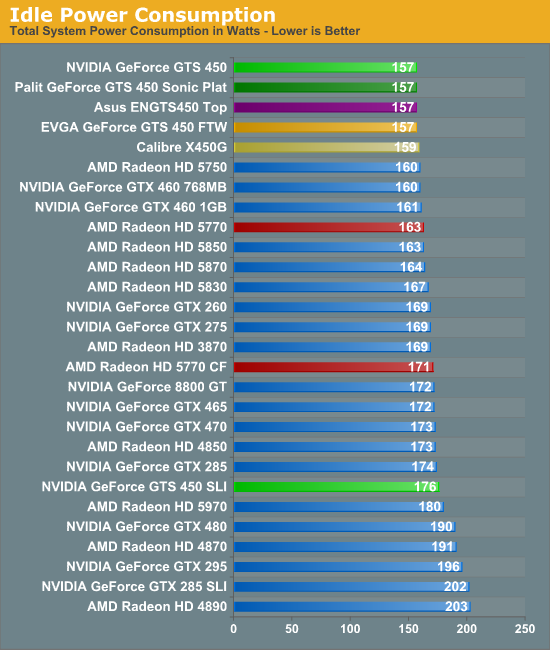
NVIDIA does not provide an official idle TDP, however it’s very clear that it must be very low. All of our GTS 450 cards bring in the lowest idle power consumption levels on this chart. We know the 5750 is rated for 16W at idle, so it’s safe to assume that the GTS 450 can beat that. Given the extremely low idle clocks of the GTS 450 (50MHz core, 270MHz memory) there’s a good chance this is the reason for the impressive idle power consumption.
We haven’t talked about SLI/CF much, but it bears mentioning here. NVIDIA doesn’t have an equivalent of AMD’s Ultra Low Power State for slave cards, which is why the GTS 450 can beat the 5770 as a single card, but lose in SLI/CF.
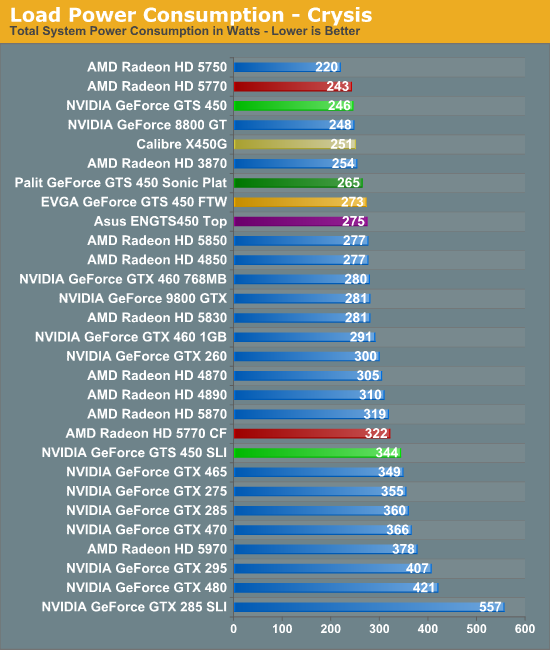

Under load the GTS 450 allows for some very low system power consumption numbers, however it can’t best the 5770. GF106 is a bigger die with more transistors so it’s not surprising that NVIDIA ends up drawing a bit more power here. But their performance also isn’t usually on par with the 5770, so they aren’t in a position to match AMD’s solid performance-per-watt. The overclocked cards do worse here of course, the worst of which is approaching 5850 power levels (and a testament to the 5850’s capabilities).
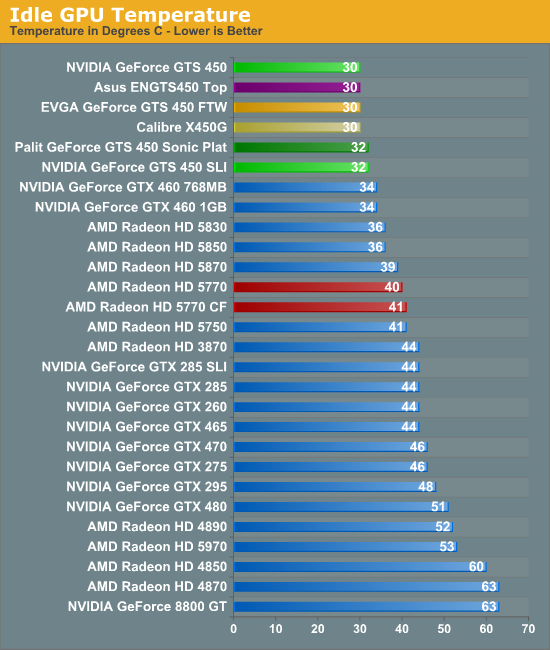
Along with giving us some of the lowest idle power numbers we’ve seen for a mainstream card, the GTS 450 also gives us the coolest temperatures. Even the GTX 460 can’t compete with the GTS 450, whose GPU barely breaks room temperature with the reference card. It’s also one of the few things the Radeon 5700 series is decidedly worse at, with the coolest of those cards getting up to 40C.
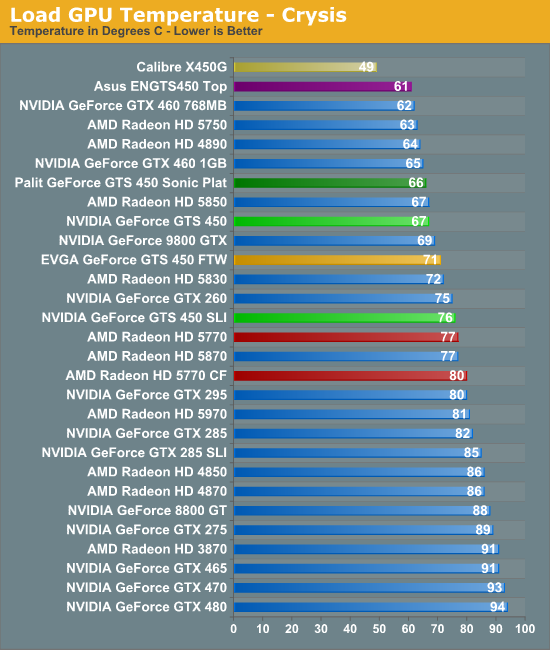

We’ll get to the Calibre card in our companion article focusing on the vendor cards, but for now we’ll stick to the reference and reference-like cards. The GTS 450 represents NVIDIA’s continued use of aggressive cooling. With a smaller all-aluminum heatsink it can’t hope to match the GTX 460, but at the same time it’s a good 10C ahead of the 5770 when it comes to Crysis. Even under Furmark the factory overclocked cards still only reach 5770 temperatures, showcasing just how good the cooling on these cards is.
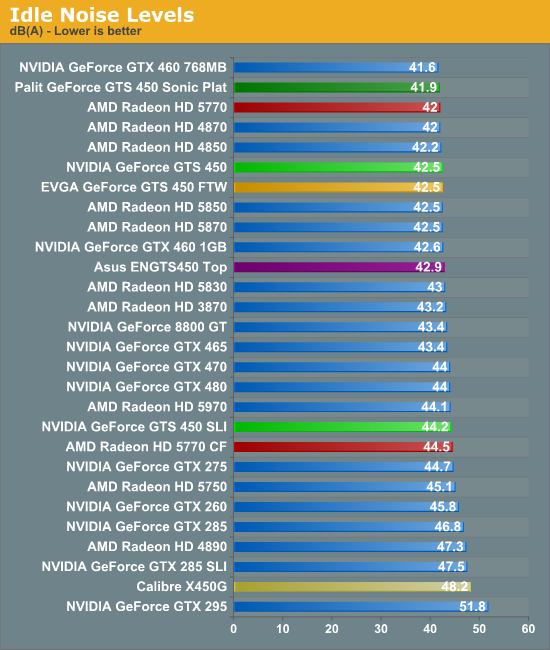
As always, the amount of noise generated at idle for a good card should be indistinguishable from other cards. The GTS 450 is no exception, generating around 42 dB(A) as we’ve come to expect.

Traditional wisdom for a video card is that if you have (relatively) high power draw you can either have a cool card or a quiet card but not both. The GTS 450 breaks the idiom wide-open – we’ve already established it draws more power than the 5770, and yet our reference card barely breaks the noise floor. At 43.3dB(A) it’s effectively silent, a feat not even the GTX 460 or the 5770 can claim. If you can ventilate your case at similarly quiet levels (necessary by fact that the GTS 450 exhausts some hot air in to the case) then we’re certainly looking at a contender for one of the most balanced HTPC cards ever.
Quickly, SLI is a bit of a different story. The reference design is great for a single card, but having two of such cards right next to each other truly suffocates the first card. We’ve said it once and we’ll say it again: if you can separate your Fermi cards, it’s in your best interest to do so.










66 Comments
View All Comments
FragKrag - Monday, September 13, 2010 - link
Why isn't there a SC2 bench? :(I saw them on the laptop reviews and expected them here :(((((
Ryan Smith - Monday, September 13, 2010 - link
Because of the vast number of cards in our library, we only refresh the GPU test suite twice a year. It will get refreshed later this fall, and SC2 is a very likely candidate.Gomez Addams - Sunday, September 19, 2010 - link
When you do your refresh please include older cards like the GTX285 and those of its era. I find it helpful to be able to evaluate whether a video card update will be of any value. So far, it would be of very little value.ronnybrendel - Monday, September 13, 2010 - link
http://www.legitreviews.com/article/1408/11/eanazag - Monday, September 13, 2010 - link
Regretfully, I am patiently waiting for the test suite refresh.Leyawiin - Monday, September 13, 2010 - link
Prior to Newegg pulling them there were lower priced ones at $130 going up to $140. Its true if you play the rebate game you can get an HD 5770 at that price, but what's coming out of your pocket on the day you buy is generally $140-150. HD 5750s are sitting at $120-140. GTX 460 768MBs are down to $170 (no rebate) so the pressure seems to be on the Radeons as much as the GTS 450. The HD 5750 is almost a useless purchase when the others are clustered so closely to its price point.iwodo - Monday, September 13, 2010 - link
It is too bad that we wont get a 28nm die shrink of the Fermi soon. But it seems the logical plan for Nvidia is to work on Frequency and Bandwidth.You mention Nvidia has a relatively poor Memory Controller for GDDR5 and that is why it had to use 384bit MC where 256 from a ATI design would be enough.
It we get a MC upgrade, + some better Frequency Headroom, and unlock the last bit of the SP, Nvidia should be able to counter the Northen Island coming in 2 - 3 months time.
As that would be the best we can get with 40nm limit and respin of Fermi.
DMisner - Monday, September 13, 2010 - link
How does the 450 stand up to the 250 in power consumption and general gaming performance.Also, any word on how many PPD the GTS 450 will get in Folding@Home?
lecaf - Monday, September 13, 2010 - link
heyin all these benchmarks the 450 beats the 460 is that right ?
I've took a look at tomshardware review and there the 460 wins.
Did I miss-look at something or the figures are wrong?
Ryan Smith - Monday, September 13, 2010 - link
Where are you seeing the GTS 450 beating the GTX 460?